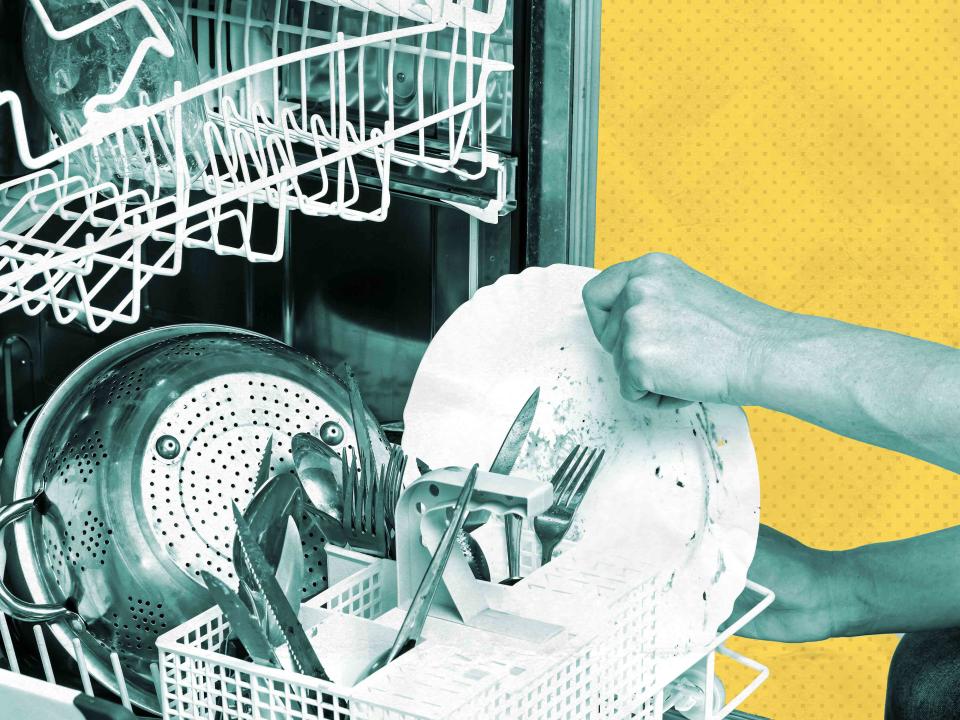Cascade Settles the Debate: Should You Be Rinsing Your Plates Before Loading the Dishwasher?
To rinse or not to rinse? We have the definitive answer.

I have a confession to make: I’m a pre-rinser. Before I load dirty dishes into our dishwasher, I thoroughly rinse them off so that they’re nearly clean before being placed in the racks. But I’m not sure why I do it. Perhaps it was the thing to do when I was growing up and doing my chores, or maybe it’s because I’m worried about the water pressure and plumbing in our 1940s home.
Turns out, I’m not alone in my pre-rinsing habit. A recent survey commissioned by Procter & Gamble shows that 86% of us pre-rinse or pre-wash as part of our dishwashing routines.
I began to wonder, is my taking the time to pre-rinse dishes before loading them into the dishwasher beneficial in any way, or is it a waste of time and resources, like water? I reached out to dishwasher detergent giant Cascade to find the answers.
Do You Need to Pre-Wash Your Dishes Before Putting Them in the Dishwasher?
According to Cascade Senior Scientist Morgan Eberhard, the answer is no. But there is a caveat.
“You want to make sure to scrape off any chunks of remaining food that could potentially gunk up or clog your machine, but go ahead and leave that last layer of food soil, sauces, and grease on the dishes,” advises Eberhard. “No need to turn the water on at all.”
She adds that we can all save water and energy, not to mention time, by using the dishwasher and skipping the pre-rinse-wash.
“Energy Star-certified dishwashers use less than four gallons of water in one cycle; a running sink can use the same amount in just two minutes,” Eberhard tells Allrecipes. “By skipping the sink and using your dishwasher every day, you can save 100 gallons of water per week."
“Energy Star-certified dishwashers also use less energy than washing dishes at the sink, so you can save money on your utility bill by using the dishwasher as well,” she adds.
Thinking of my home’s aging, and perhaps fragile, plumbing, I asked Eberhard how dishwasher soaps like Cascade break down the food, sauces, and grease left of dirty plates sitting in the dishwasher.
“Super-packed dishwasher detergent [like Cascade Platinum Plus!] has a powerful combination of cleaning ingredients that hydrate and scrub tough, dried-on food resulting in virtually spot-free, cabinet-ready dishes,” she explains. “The dual-power cleaning formula is composed of starch-fighting and protein-fighting enzymes that break down tough-to-clean foods better than ever before.”
Tips for Loading a Dishwasher Efficiently
Now that we have the definitive answer that it’s not necessary to pre-rinse or pre-wash dishes before loading them into the dishwasher, I asked Eberhard for her tips on how to make sure our dishes come out spotless every time.
"“The most important thing to remember when loading the dishwasher is that the water coming from the spray arms has to be able to reach the dirty part of the dish. If bowls are nesting together or dishes are stacked on top of one another, the water won’t be able to get to them, meaning the detergent won’t be able to break down the food and grease left on the dish."
"
Cascade Senior Scientist Morgan Eberhard
“Make sure each dish has a clear path to the water source in each load for optimal cleaning,” Eberhard continues. “The same goes for your flatware. By design, spoons like to, well, spoon. Try to mix up what type of utensils are in each section of your cutlery basket so they don’t end up resting together.”
She adds that the best way to ensure forks and spoons are their cleanest when they come out of the dishwasher is to load them standing up, “so the dirtiest part is more exposed to the water instead of getting packed into the bottom of the basket.” Be sure to load knives down for safety, “so you don’t accidentally cut yourself while unloading.”
Additional dishwasher loading tips from Cascade include:
Double check items are dishwasher safe: A dishwasher may be too rough for some prized kitchen items, or might not be appropriate for some materials, like wood, aluminum, and cast iron. Be sure to double-check that all items are dishwasher safe before loading if you’re unsure.
Load the bottom rack: Put plates and messy, burnt-on pots and pans on the bottom rack in the direction of the prongs, facing the water source. Typically, the water source is in the center of the machine, and you want as clear a path as possible between the spray and your dirty dishes.
Load the top rack: Place cups, mugs, and bowls face down on the top rack between prongs to prevent rattling. This way, they’ll also get cleaned better and won’t collect water, which can leave behind unsightly deposits. With wine glasses and other delicate glassware, load them a finger-width apart on the top rack and utilize the stemware holder, if your dishwasher has one, to keep them in place so they don’t fall over. Plasticware also belongs on the top rack. Temperatures typically remain cooler on the top rack, which will prevent plastic from melting.
Read the original article on All Recipes.

